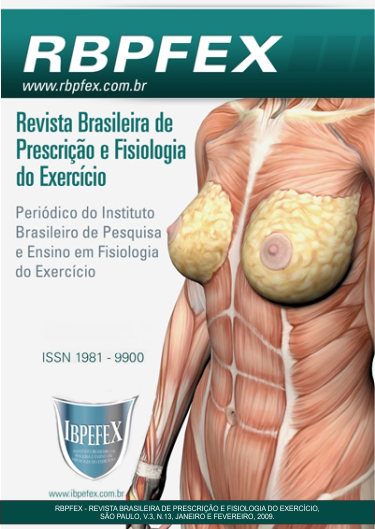Chronic resisted physical exercise promotes blood pressure regulation and may influence panic disorder recovery: Case study
Abstract
Studies have demonstrated the resisted exercises success on the reduction of arterial pressure after training. Still very limited the studies that come up with the efficiency to revert the panic syndrome, for that reason, the present study has the objective to compare the effect of arterial pressure and the reaction of the panic syndrome in a study of the hypertension person case, taking medication, after twenty and four sessions of strong practice in a circuit with three phases. For this, controlled by a pharmacist, a hypertension sedentary volunteer of the feminine sex (56 years) with panic syndrome and without experience in the strong practice was studied. The study was done in three times at week, in alternated days. The measurement of arterial pressure was carried through in ergometric tests made before and after the twenty and four sessions of practice. Concerning the panic syndrome the evaluation was completed by a subjective method through volunteer description. Analyzing the measures of the arterial pressure before and after practice, was verified that it had a reduction of the systolic arterial pressure of 15.38%, after the exercise, and a reduction of the diastolic arterial pressure of 12.5%, before the work out. So, it purpose a conclusion that the moderate intensity resisted exercise in circuit form, carried through three times at week reduce the arterial pressure after twenty and four sessions of practice, seems to help a progress in the panic syndrome symptoms.
References
- Araújo, S.R.C. de.; Mello, M.T. de.; Leite, J.R. Transtornos de Ansiedade e Exercício Físico. Revista Brasileira de Psiquiatria. São Paulo, 2006.
- Barros Neto, T.L. A atividade física e seu efeito ansiolítico. Âmbito Medicina do Esporte. 1996; 24(3) 3-14.
- Bermudes, A.M.L.; e colaboradores. Monitorização Ambulatorial da Pressão Arterial em Indivíduos Normotensos Submetidos a Duas Sessões Únicas de Exercícios: Resistido e Aeróbio. Arq Bras Cardiol, volume 82 (nº 1), 57-64, 2003.
- Bernik, M. Relevância médico-social do transtorno de pânico. Revista de psiquiatria clínica, volume 27 nº 6, 2000.
- Carneiro, J.A.; Silva, K.L. da; Moreira, L.S.; Borges, R.O. Respostas Cardiovasculares do Treinamento Resistido: Uma Revisão. Artigo de revisão - 2003.
- Ciolac, E.G.; Guimarães, G.V. Exercício físico e síndrome metabólica. Revista Brasileira de Medicina do Esporte, vol.10 no. 4 Niterói Julho/Agosto.2004. Acessado em: 22/02/07.
- Fleck, S.J.; Krainer, W.J. Fundamentos do treinamento de força muscular. 2ª ed., Porto Alegre, Ed. Artes Médicas Sul L.T.D.A, 1999.
- Forjaz, C.L.M.; Rezk, C.C.; Melo, C.M.M.; e colaboradores. Exercício resistido para o paciente hipertenso: indicação ou contraindicação? Revista Brasileira de Hipertensão. 2003;10: 119-124.
- Fox, E.L.; Bowers, R.W.; Foss, M.L. Bases Fisiológicas da Educação Física e dos Desportos. 4ª ed. Rio de Janeiro. Guanabara Koogan. 1991. p. 185 - 187.
- MacCartney, N. Role of Resistance training in Heart Desease. Med. Sci. Sports Exercises; v. 30, n. 10 p-396-402, 1998.
- Mello, M.T. O exercício físico e os aspectos psicobiológicos. Revista Brasileira de Medicina do Esporte. Vol. 11, n. 3. Maio-Junho, 2005.
- Monteiro, M. de F.; Filho, D.C.S. Exercício Físico e Controle da Pressão Arterial. Revista Brasileira de Medicina do Esporte. Niterói. Vol. 10. Num. 6. 2004. p. 513
- Moore, B.E.; Fine, B.D. Dicionários de termos e conceitos psicanalíticos. Porto Alegre. Artes médicas, 1992.
- Negrão, C.E.; Rondon, M.U.P.B. Exercício físico e controle barorreflexo da pressão arterial. Revista Brasileira de Hipertensão. V.8/89-95. Janeiro-março 2001.
- Nóbrega, A.C.L. O conceito de efeitos sub-agudos do exercício. Rev. Bras. Educ. Fís. Esp., São Paulo, v.20, p.85-86, set. 2006. Suplemento n.5. • 85
- Polito, M. Respostas de frequência cardíaca, pressão arterial e duplo produto ao exercício contra-resistência: uma revisão da literatura. Revista Portuguesa de Ciências do Desporto. Vol. 3. Num. 1. p. 79 – 91. 2003.
- Robergs, R.A.; Roberts, S.O. Princípios Fundamentais de Fisiologia do Exercício: para Aptidão, Desempenho e Saúde. São Paulo. Phorte. 2002. p. 433 – 434.
- Scarpaton, A.T. O estranho que me habita: a Síndrome do Pânico numa perspectiva formativa. Revista Reichiana do Instituto Sedes Sapientiae, São Paulo, número 10, 2001, p. 50-66
- Ramos, R.T. As bases biológicas do transtorno de pânico. Revista de Psiquiatria Clínica. 28-1, 2001. São Paulo.
- Sharkey, B.J. Condicionamento físico e saúde. 4ª ed. Porto Alegre. Artmed. 1998. p. 36.
- Werner, R. Guia de Patologia para Massoterapeutas. 2ª ed. Rio de Janeiro. Guanabara Koogan. 2005. p. 214 – 217.
- Wilmore, J.H.; Costill, D.L. Fisiologia do Exercício e do Esporte. 2ª ed. São Paulo. Manole. 2001. p. 639.
Authors who publish in this journal agree to the following terms:
- Authors retain the copyright and grant the journal the right of first publication, with work simultaneously licensed under the Creative Commons Attribution License BY-NC which allows the sharing of the work with acknowledgment of the authorship of the work and initial publication in this journal.
- Authors are authorized to enter into additional contracts separately for non-exclusive distribution of the version of the work published in this journal (eg, publishing in institutional repository or book chapter), with acknowledgment of authorship and initial publication in this journal.
- Authors are allowed and encouraged to post and distribute their work online (eg, in institutional repositories or on their personal page) at any point before or during the editorial process, as this can bring about productive change as well as increase impact and impact. citation of published work (See The Effect of Free Access).






